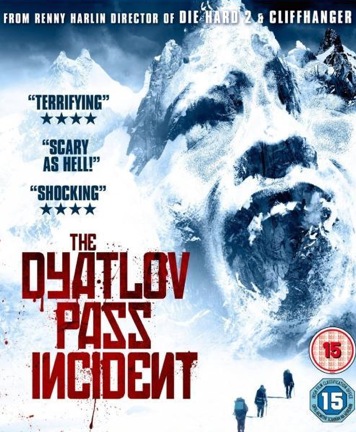Studio: IFC Midnight
Director: Renny Harlin
Writer: Vikram Weet
Producer: Kia Jam, Renny Harlin, Alexander Rodnyansky, Sergei Bespalov, Sergey Melkumov
Stars: Holly Goss, Matt Stokoe, Luke Albright, Ryan Hawley, Gemma Atkinson
Review Score :
Summary:
Five University of Oregon students film an investigation into “The Dyatlov Pass Incident,” where nine Russian hikers met mysterious deaths in the Ural Mountains.
Review:
NOTE: "The Dyatlov Pass Incident" was retitled "Devil's Pass" for North America.
“Found footage” as a sub-genre has to be the easiest target for horror film criticism. The format is restrictive to such a point that it is little surprise why so many of the films are similar not just in the stories that they choose, but also in the mistakes that they make. The complaints are as routinely common as the plot of having paranormal investigators wander a haunted asylum. “The handheld camera shakes too violently. Why are they constantly filming everything? Haven’t I already seen a million night vision shots of a gape mouthed phantom before?” And so on and so forth.
In thinking about these sigh-inducing observations that some make about “found footage” while watching director Renny Harlin’s entry into the sub-genre, there was a realization that “The Dyatlov Pass Incident” may well fit under the timeless adage, “you’re damned if you do, and you’re damned if you don’t.” With so many other films having worn Grand Canyon-sized grooves in the formula, Harlin and his filmmakers seemingly noted the common missteps of “found footage,” and actively worked on countermeasures. As it so happened, the alternative routes they chose came with an entirely different set of issues.
The camerawork abandons overly unbalanced shakes and darkly grainy film for a clean look and smoother style that is unbelievably crisp for one camera being a handheld and another being a phone. Each time the camera is set down in the snow, it also serendipitously captures the onscreen action in a shot that is still perfectly framed. Harlin has solved the problem of making it too hard to see what is happening all of the time, but the professional quality betrays the “found footage” conceit.
Ditto for the dialogue. Many “found footage” horrors throw their actors into a half-baked idea and cross their fingers that the improvisation will seem like a thought out plot. “The Dyatlov Pass Incident” gives its actors a bona fide script, and then suffers from scenes that feel too rehearsed and prepared.
“The Dyatlov Pass Incident” is rooted in a true story. In 1959, Igor Dyatlov rounded up nine friends and set off to hike the treacherous snows of Kholat Syakhl in the Ural Mountains of Russia. The hikers may have been tempting a terrible fate, as Kholat Syakhl translates to, “Mountain of the Dead.” Yuri Yudin was the only survivor, having left the group mid-trek due to illness. The other nine hikers went on to die mysteriously on the night of February 2, 1959.
Hikers dying in freezing temperatures or on rugged terrain is not unusual in itself, but these particular deaths were inexplicably strange. Investigators located the group’s campsite and found that their tent had been torn open from the inside. The hikers left their belongings behind and fled without shoes. Bodies were gradually discovered over a period of two months. Two were found wearing only underwear. Other corpses had fractured skulls and broken ribs, yet no signs of external wounds or a struggle. Group member Ludmila Dubinina was missing her tongue. And some articles of clothing showed high traces of radiation.
Actual photo of Igor Dyatlov, Yuri Yudin, and Ludmila Dubinina.
Since the four injured bodies were found in a nearby 13-foot ravine, a sensible assumption is that an avalanche caused the hikers to flee suddenly. Those who fell in the ravine then broke their bones and even bit off a tongue. But conspiracy theorists have more imaginative explanations. “Orange spheres” in the night sky reported by other hikers suggest extraterrestrials. The radiation points to military experiments and a government coverup. Fuel went on this fire when documents from the official inquest later went missing. Some even refuse to rule out a possible attack by the indigenous Mansi tribe.
With so many sinister possibilities, the story is rife with seeds for sowing horror. And like the conspiracy theorists, “The Dyatlov Pass Incident” movie cannot come to a consensus about which idea works best for its plot. So it throws them all in a pot and sets the script to boil.
The horror at the film’s heart is a fusion of possible Yeti attacks, wormholes, teleportation, fanged creatures, extraterrestrial mythology, and enough ancillary ideas to power an entire season of “The X-Files.” The story tries covering so much ground that the resulting blend of ideas is too fantastical to be believable as “found footage.” This is one of those handheld mockumentaries that may in fact have been better served by going the traditional film route. Instead, the first person perspective in the fast paced finale creates the look and feel of being on a Universal Studios dark ride, complete with creature effects straight out of “The Mummy.”
The story nicely ties in a pair of connections to real world personalities involved in the actual case. Author Yuri Yarovoi, who was first to write a fictionalized account of what happened at Dyatlov Pass, is suggested to have been assassinated in a suspicious auto accident. Actual lone survivor Yuri Yudin also figures into the story. Although Yudin died in 2012, he is renamed Piotr Karov in the film, presumably because he is depicted as an institutionalized madman, which Yudin was not.
For all the trouble “The Dyatlov Pass Incident” goes through to tie in true facts, it allows some of these threads to undo the supposed authenticity. For starters, why would the government keep Karov/Yudin alive if they were afraid of him revealing the truth about Dyatlov Pass? And why would the students be given permits to explore the area in the first place if the government wanted to keep what was hidden there a secret?
The film might have applied for clemency for at least trying to avoid the most typical “found footage” obstacles, except that it commits the cardinal sin of the sub-genre. So many “found footage” movie reviews draw “Blair Witch” comparisons that it is now just as derivative to use that film as a reference point in criticism. But it begs to be mentioned here because “The Dyatlov Pass Incident” is pulled from an identical formula nearly point by point.
The Blair Witch Project
* Doc about mysterious woods.
* Interviews with locals.
* Campsite found disturbed in the morning.
* Hikers become lost.
* Campers flee their tents in the night.
* Heather finds a tongue.
* Heather apologizes on camera.
The Dyatlov Pass Incident
* Doc about mysterious mountains.
* Interviews with locals.
* Campsite found disturbed in the morning.
* Hikers become lost.
* Campers flee their tents in the night.
* Holly finds a tongue.
* Holly apologizes on camera.
That list is rudimentary, and could have dozens more lines, but the gist is clear. “The Dyatlov Pass Incident” tries to stretch its arms out of the mold, and then leans too heavily on the tropes that horror fans have been overfed since 1999. It may be that the film had its work cut out for it no matter which route it took, but one more old adage seems to be a shoe that fits: “Close, but no cigar.”
Review Score: 45








The subtitle “A Dracula Story” only makes sense if you have a liberal interpretation of what “Dracula” means in this context.